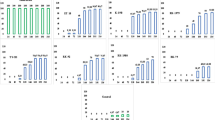Abstract
The efficacy of two commercial products of Bactospeine and Bio-fly onPrays citri of lime trees was studied under laboratory and field conditions throughout the two seasons of 1996 and 1997. Laboratory results indicated that the pathogenic effect of Bactospeine,Bacillus thuringiensis (Berliner) was higher than that of Bio-fly,Beauveria bassiana in spite of the latter was applied with higher doses. Bactospeine at the rate (2 cc/1 l.w.) effected on the larvae more than on the adults, that treatment reduced no. of eggs/female by 81.70% and decreased the larval infestation by 90.08%. Bio-fly at the highest concentration (4 cc/1 l.w.) reduced the infestation with the eggs, the larvae and the pupae by 65.83%, 68.45% and 72.55%, respectively. Advanced effects of bacterial and fungal treatments on the final reduction rates ofP. citri infestation were recorded. Field applications revealed that two sprays with Bactospeine or Bio-fly gave good control ofP. citri more than one spray. Bactospeine at the rate (2 cc/1 l.w.) and Biofly at the rate (4 cc/1 l.w.) reduced the infestation by (89.82–93.43%) and (76.32–78.83%), respectively. In all cases, higher doses of bioinsecticides produced potentiation effects of infestation reduction. It is recommended that two sprays of Bactospeine at a rate (2cc/1 l.w.) are adequate effective to reduce the population of P. citri in lime orchards during the main flowering period of trees without need of chemical insecticides.
Similar content being viewed by others
References
Attia, M. B.;Attlla, A. S.;Abd-El-Rahim, M. M.;Mansour, M. F., 1992: Control studies on citrus flower moth (Prays citri Mill.) in relation to yield and fruit quality of Balady lime. Minufia Journ. Agric. Res. Egypt,13, (3), 1691–1700.
Benfatto, D., 1990: Observations on the chemical control of citrus pests: use of pheromone traps to monitorArchips rosanus L. andPrays citri Mill. in Italy. Rev. Agric. Ent. 078-02765.
Carls, L., 1984: The citrus flower moth. Hortic. Abstr. 054-05811.
Dixon, W. J.;Massey, F. J. Jr., 1969: Introduction to statistical analysis. Third edition, Mcgraw Hill Book Comp. (New York —San Fransisco—St. Louis, Toronto, London, Sydney) 109–119.
Kamburov, S. S., 1986: New pests and beneficial insects on citrus in South Africa—Part I. Citrus and Subtropical Fruit Journal,625, 6–7, 9–11.
Morena, J.; Falco, J. V.; Jimenez, R., 1993: Study of the parasitoid complex ofPrays citri Mill. (Lep.: Hyponomeutidae) in the South of Alicante province, Spain. Rev. Agric. Ent. 801–806.
Shehata, W. A., 1982: Biological ecological and control studies on the citrus flower moth,Prays citri Mill. (Lep.; Hyponomeutidae) in Egypt. M.Sc. Thesis, Fac. of Agric., Cairo Univ.
Snedecor, G. W. Cochran, W. G., 1961: Statistical methods. Fifth edition, Ames, Iowa, U.S.A.
Author information
Authors and Affiliations
Additional information
An erratum to this article is available at http://dx.doi.org/10.1007/BF02769006.
Rights and permissions
About this article
Cite this article
Shetata, W.A., Nasr, F.N. Laboratory evaluation and field application of bacterial and fungal insecticides on the citrus flower moth,Prays citri miller (Lep., hyponomeutidae) in lime orchards in Egypt. Anz. Schadlingskde., Pflanzenschutz, Umweltschutz 71, 57–60 (1998). https://doi.org/10.1007/BF02770622
Issue Date:
DOI: https://doi.org/10.1007/BF02770622




